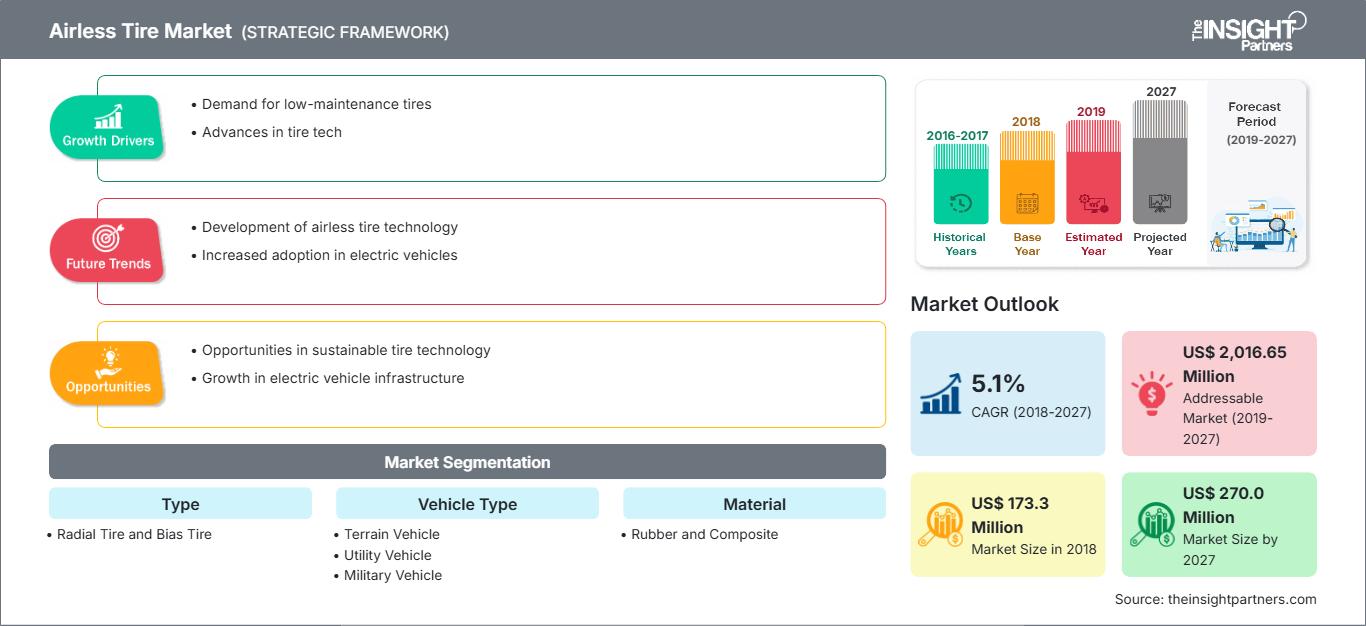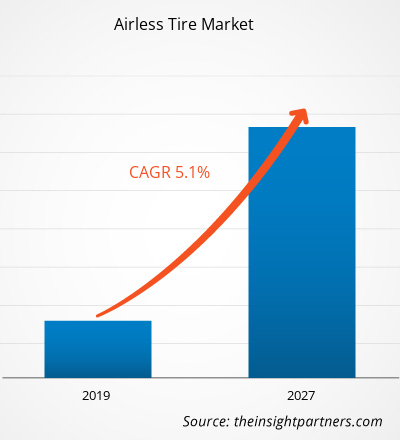Der globale Markt für luftlose Reifen hatte im Jahr 2018 einen Umsatz von 173,3 Millionen US-Dollar und soll bis 2027 270,0 Millionen US-Dollar erreichen. Im Prognosezeitraum 2019–2027 wird ein CAGR-Wachstum von 5,1 % erwartet.
Der Markt für luftlose Reifen ist grob in fünf Hauptregionen unterteilt: Nordamerika, Europa, APAC, MEA und SAM. Die bedeutendste Region im globalen Markt für luftlose Reifen ist Nordamerika, gefolgt vom asiatisch-pazifischen Raum und Europa. Die Dominanz Nordamerikas auf dem Markt für luftlose Reifen ist darauf zurückzuführen, dass in der Region mehrere Hersteller von luftlosen Reifen ansässig sind, die erheblich von der Forschung und Entwicklung des Produkts profitieren. Die USA sind der größte Markt in Nordamerika sowie im globalen Markt für luftlose Reifen und werden den Markt im Prognosezeitraum 2019–2027 voraussichtlich dominieren. Der Markt für luftlose Reifen wird im Prognosezeitraum weltweit stark wachsen. Die Verbreitung von luftlosen Reifen nimmt in verschiedenen Regionen und Fahrzeugtypen stetig zu. Die Vorteile luftloser Reifen beeinflussen verschiedene Branchen, darunter Bauwesen, Landwirtschaft, Handel, Bergbau und Militär. Der Markt für luftlose Reifen befindet sich noch in der Anfangsphase. Mehrere etablierte Unternehmen sowie kleinere Akteure sind auf dem Weltmarkt aktiv.
Passen Sie diesen Bericht Ihren Anforderungen an
Sie erhalten kostenlos Anpassungen an jedem Bericht, einschließlich Teilen dieses Berichts oder einer Analyse auf Länderebene, eines Excel-Datenpakets sowie tolle Angebote und Rabatte für Start-ups und Universitäten.
Markt für luftlose Reifen: Strategische Einblicke

-
Holen Sie sich die wichtigsten Markttrends aus diesem Bericht.Dieses KOSTENLOSE Beispiel umfasst Datenanalysen, die von Markttrends bis hin zu Schätzungen und Prognosen reichen.
Der globale Urbanisierungstrend nimmt exponentiell zu. Dadurch steigt auch das durchschnittliche verfügbare Einkommen der in Großstädten lebenden Bevölkerung. Die Fahrzeugproduktion hat in der Zeit nach der Rezession seit 2010 stetig zugenommen. Ein Schlüsselbereich ist der Schwermaschinen- und Nutzfahrzeugsektor, der sich durch ein hohes Maß an Innovationstätigkeit und Entwicklungen im Bereich der Verkehrssicherheit auszeichnet. Die Vergrößerung des Fuhrparks hat zu einer Zunahme von Unfällen geführt, die durch verschiedene Faktoren, wie z. B. ungeeigneten Reifendruck, verursacht wird. Schwermaschinen mit luftlosen Reifen können im Vergleich zu Luftreifen mehr Gewicht tragen und sind für anspruchsvollere Aktivitäten geeignet.
Einblicke in das Typsegment
Nach Typ betrachtet dominierte das Segment der Radialreifen 2018 den globalen Markt für luftlose Reifen. Bei einem Radialreifendesign sind die Kordlagen im 90-Grad-Winkel zur Fahrtrichtung bzw. von der Reifenmitte (radial) angeordnet. Bei einem Radialreifen fungieren Lauffläche und Seitenwand als zwei unabhängige Elemente des Fahrzeugreifens.
Einblicke in das Materialsegment
Materialbezogen dominiert das Gummisegment den globalen Markt für luftlose Reifen. Ein herkömmlicher Reifen besteht aus luftgefülltem Gummi, der mithilfe von Druckluft gepackt wird. Luftreifen dominieren den globalen Reifenmarkt.
Einblicke in das Fahrzeugtypsegment
Nach Fahrzeugtyp betrachtet, hatte das Segment Nutzfahrzeuge 2018 den größten Anteil am globalen Markt für luftlose Reifen. Nutzfahrzeuge umfassen unterschiedliche Fahrzeugtypen, die in zahlreichen Industrieanwendungen eingesetzt werden. Diese Fahrzeuge werden entwickelt und hergestellt, um bestimmte Aufgaben effektiver und effizienter auszuführen als Personenkraftwagen.
Die Marktteilnehmer konzentrieren sich auf Produktinnovationen und -entwicklungen, indem sie fortschrittliche Technologien und Funktionen in ihre Produkte integrieren, um mit der Konkurrenz mithalten zu können.
- 2019 hat Michelin Tweel Technologies, eine Abteilung von Michelin North America, Inc., einen neuen 26-Zoll-Luftlos-Radialreifen mit einer Nabe mit Vierloch-Radialmuster eingeführt, der für UTV (Utility Vehicle oder Utility Task Vehicle) entwickelt wurde.
- 2018 ist Michelin eine Partnerschaft mit General Motors eingegangen, um den Prototyp Uptis zu testen und zu erproben, der ab 2024 in Autos eingebaut werden soll.
- 2017 hat Toyo Tires die Entwicklung von „noair“ angekündigt, einem neo-futuristischen Luftlos-Konzeptreifen, der keine Luftfüllung benötigt.
Der globale Markt für Luftlosreifen ist wie folgt segmentiert: Markt für Luftlosreifen – Nach Typ
- Radialreifen
- Diagonalreifen
Markt für luftlose Reifen – Nach Material
- Gummi
- Verbundwerkstoff
Markt für luftlose Reifen – Nach Fahrzeugtyp
- Geländefahrzeug
- Nutzfahrzeug
- Militärfahrzeug
Airless-Reifenmarkt – nach Region
- Norden Amerika
- USA
- Kanada
- Mexiko
- FrankreichKorea
- Japan
- Australien
- Rest von APAC
- Naher Osten und Afrika (MEA)
- Südafrika
- Saudi-Arabien
- VAE
- Rest von MEA
- Südamerika (SAM)
- Brasilien
- Argentinien
- Rest von SAM
Regionale Einblicke in den Markt für luftlose Reifen
Die Analysten von The Insight Partners haben die regionalen Trends und Faktoren, die den Markt für luftlose Reifen im Prognosezeitraum beeinflussen, ausführlich erläutert. In diesem Abschnitt werden auch die Marktsegmente und die geografische Lage in Nordamerika, Europa, im asiatisch-pazifischen Raum, im Nahen Osten und Afrika sowie in Süd- und Mittelamerika erörtert.
Umfang des Marktberichts zum luftlosen Reifen
| Berichtsattribut | Einzelheiten |
|---|---|
| Marktgröße in 2018 | US$ 173.3 Million |
| Marktgröße nach 2027 | US$ 270.0 Million |
| Globale CAGR (2018 - 2027) | 5.1% |
| Historische Daten | 2016-2017 |
| Prognosezeitraum | 2019-2027 |
| Abgedeckte Segmente |
By Typ
|
| Abgedeckte Regionen und Länder |
Nordamerika
|
| Marktführer und wichtige Unternehmensprofile |
|
Dichte der Marktteilnehmer für luftlose Reifen: Verständnis ihrer Auswirkungen auf die Geschäftsdynamik
Der Markt für luftlose Reifen wächst rasant. Die steigende Nachfrage der Endverbraucher ist auf Faktoren wie veränderte Verbraucherpräferenzen, technologische Fortschritte und ein stärkeres Bewusstsein für die Produktvorteile zurückzuführen. Mit der steigenden Nachfrage erweitern Unternehmen ihr Angebot, entwickeln Innovationen, um den Bedürfnissen der Verbraucher gerecht zu werden, und nutzen neue Trends, was das Marktwachstum weiter ankurbelt.

- Holen Sie sich die Markt für luftlose Reifen Übersicht der wichtigsten Akteure
- Amerityre
- Bridgestone Corporation
- Continental
- Evolution Wheel
- Hankook Tire & Technology Co. Ltd.
- McLaren Industries
- Michelin
- Sumitomo Rubber Industries Ltd.
- The Goodyear Tire & Rubber Company
- Toyo Tire & Rubber Co. Ltd.,
- Historische Analyse (2 Jahre), Basisjahr, Prognose (7 Jahre) mit CAGR
- PEST- und SWOT-Analyse
- Marktgröße Wert/Volumen – Global, Regional, Land
- Branchen- und Wettbewerbslandschaft
- Excel-Datensatz
Aktuelle Berichte
Verwandte Berichte
Erfahrungsberichte
Grund zum Kauf
- Fundierte Entscheidungsfindung
- Marktdynamik verstehen
- Wettbewerbsanalyse
- Kundeneinblicke
- Marktprognosen
- Risikominimierung
- Strategische Planung
- Investitionsbegründung
- Identifizierung neuer Märkte
- Verbesserung von Marketingstrategien
- Steigerung der Betriebseffizienz
- Anpassung an regulatorische Trends






















 Kostenlose Probe anfordern für - Markt für luftlose Reifen
Kostenlose Probe anfordern für - Markt für luftlose Reifen